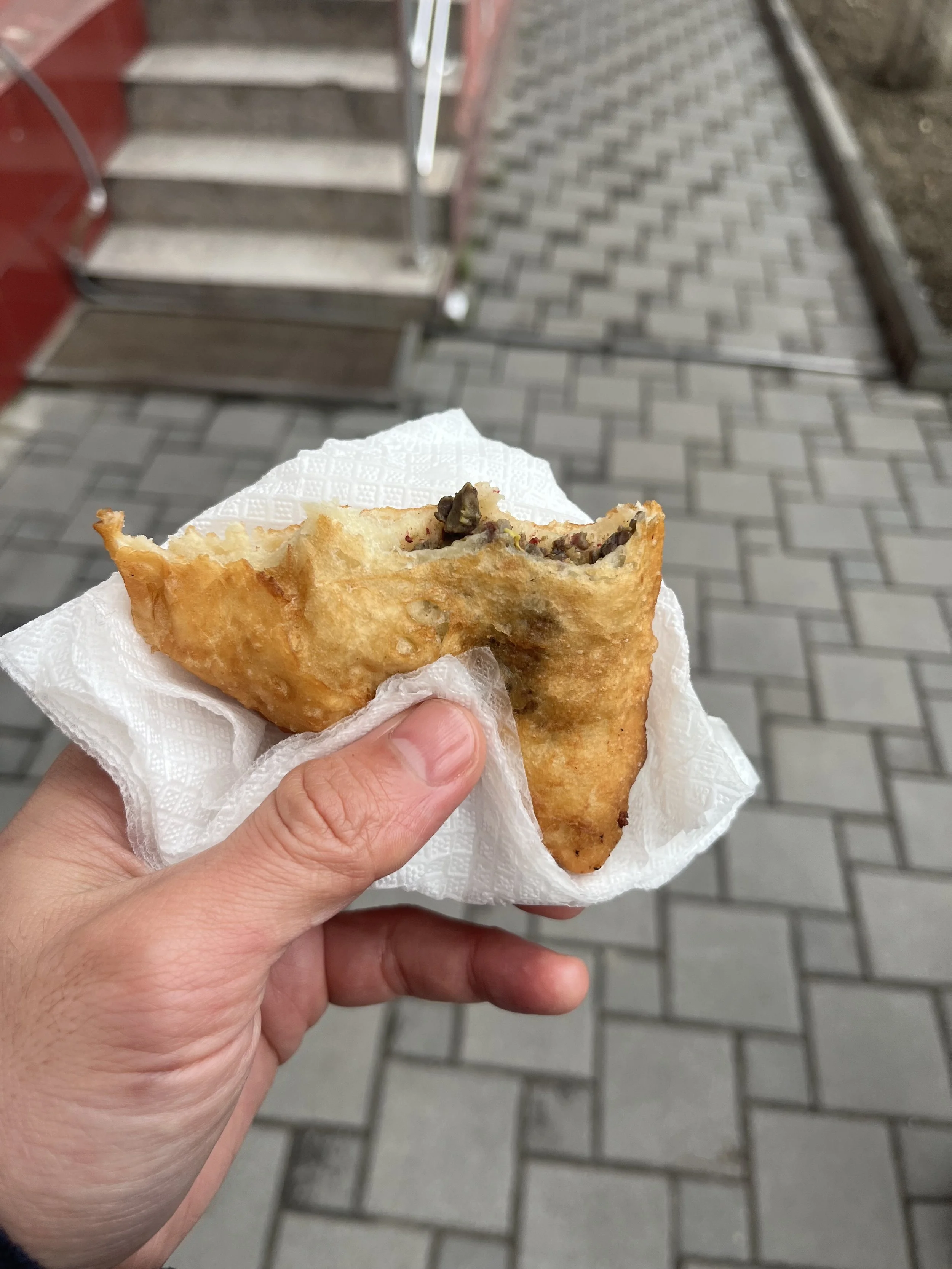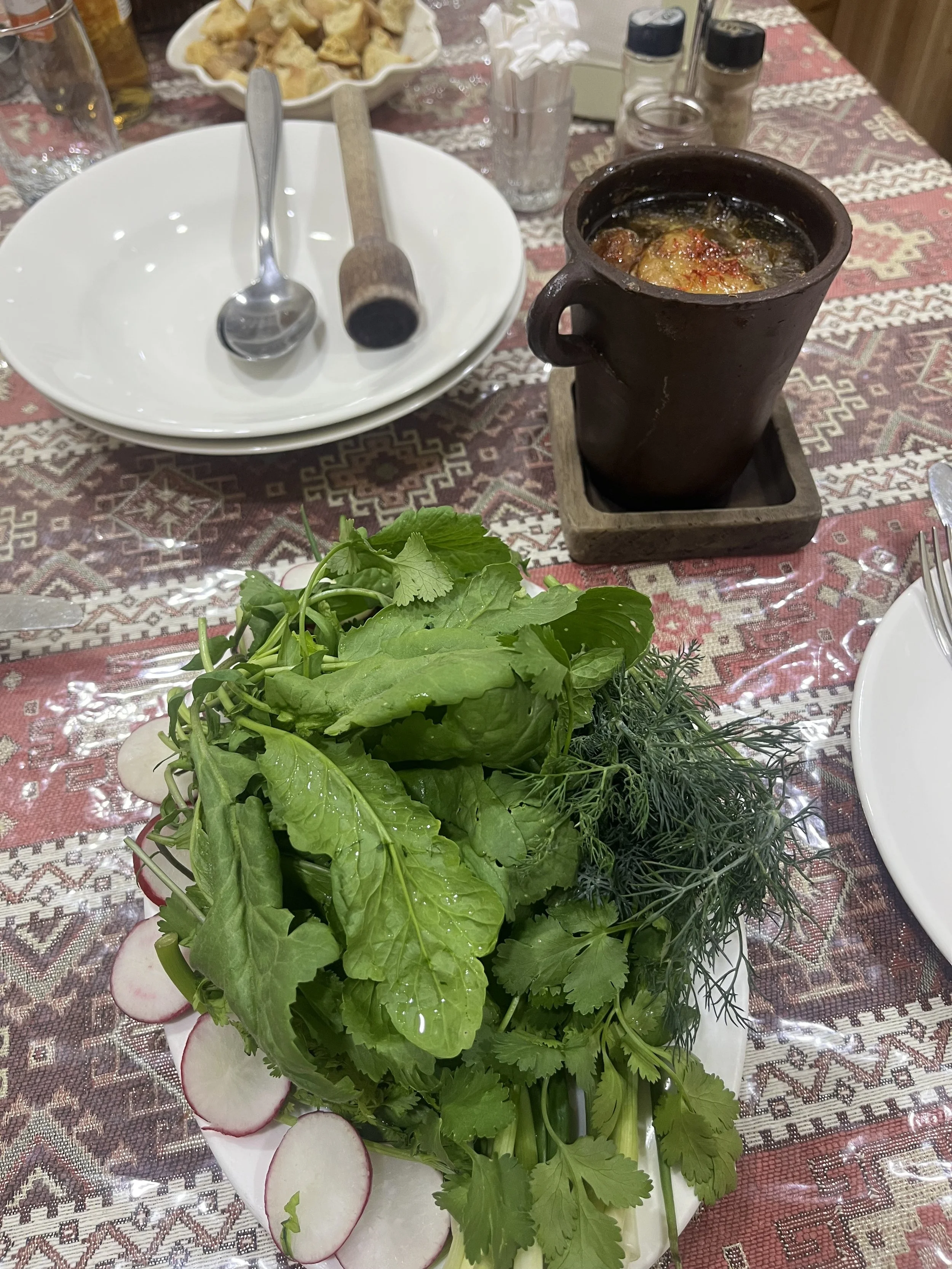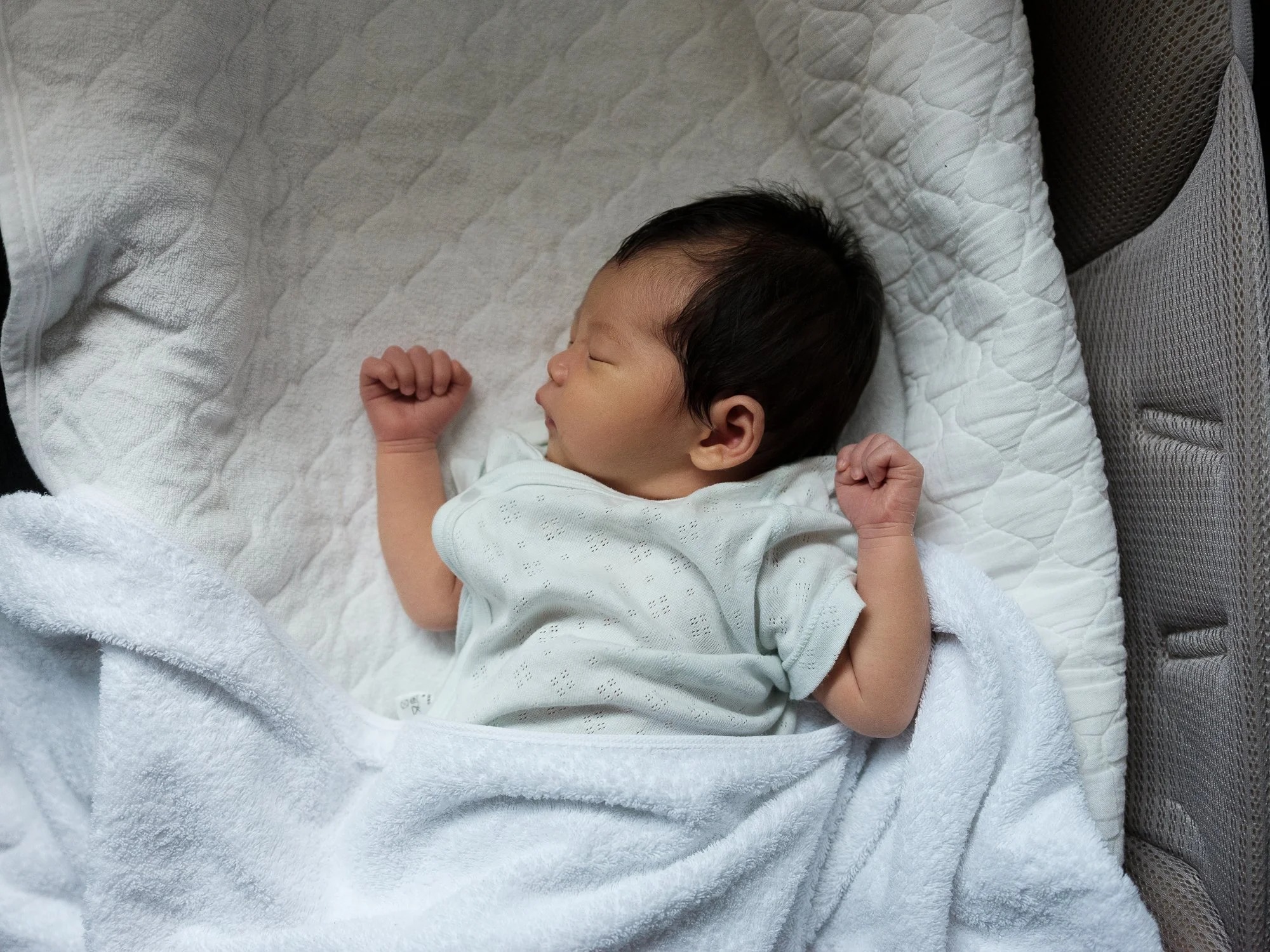(Scroll down to read in English)
アゼルバイジャンの国内旅行を振り返り記録するシリーズ。
今回は歴史ある街、シェキに訪れた旅の話。
シェキ / Sheki
シェキの細かい歴史については、とてもでは無いがここでは語り尽くせないし、私も全て理解していないので、気になる方は自分で調べてください。
かつてシルクロードにおける要所の一つで、美しい山間にあるアゼルバイジャンの観光名所。
街の中心やいくつかの建造物がUNESCO世界遺産に登録されている。
バクーから北西に240km。
地図を見るとシェキのすぐ北にはロシアとの国境があり、西にはジョージアとの国境も迫る。
私たちが住んでいたバクーとは気候も異なり、ひんやりとした山の空気が流れ込むことから、4月でもだいぶ肌寒かった。
ひんやりとした空気が心地よく、山に来たことを実感する。
山のふもとにあるシェキの街 / Town of Sheki is situated at the foot of mountains
昔この地を統治していたハーン(王朝)によって建てられた美しい宮殿はこの地の最も有名な観光名所のひとつで、ペルシャやオスマン朝の影響を受けた美しいデザインが目を惹く。
キャラバンセライという16世紀に建てられたシルクロード沿いに建てられた宿は、かつてシルクロードを行き来する商人たちの宿泊場であり、取引や交流の場であった場所。
当時の雰囲気を残した石造の建物を見て、中庭を歩きながら、色々と思いに耽る。
この場所でかつてどんな人たちが出会い、何を食べ、どんな酒を飲み、どんな話をしていたんだろう。
そんな想像をするだけでワクワクする。
ちなみに、観光客が宿泊できるお部屋もある。
雰囲気はいいけど部屋が寒いとの話を聞いて、我々夫婦は泊まらなかった。
キャラバンセライの敷地内、ちょっと奥まった庭園のようなところに行ったら、そこには可愛いうさぎちゃんが3匹、ぴょんぴょん走り回っていて、なんだか不思議な空間だった。
シェキ・ハーンの宮殿 / Palace of Sheki Khan
キャラバンセライ/ Caravanserai
キャラバンセライ敷地内にあった庭園。うさぎちゃんがお出迎え / A garden inside the Caravanserai compound where rabbits welcomed us
他にも古代の教会や、現地のモスクなど、2泊3日の滞在でシェキ中を練り歩いた。
もちろん宮殿や教会など、有名な観光名所は興味深かったが、私はそれよりもシェキの石畳の道に石造りの建物がならぶ古い街並みに魅了された。
街を練り歩きながら街の風景をスナップしたので、そのアルバムのリンクをブログの最後に貼るので、興味があればぜひみてください。
あとはたくさん美味しい食べ物にも遭遇。
ピロシキといえばロシアを連想すると思うが、アゼルバイジャンは旧ソ連の国、ピロシキも一般的なスナックとして道端で売られている。
シェキの街を練り歩く中で小腹が空いて、おじさんたちが群がっているお店で買ったピロシキ。
じゃがいもと、レバーの二種類があり、両方買う。
ジャガイモの方はディルが効いてて爽やか、レバーは細切れになったものが入っていて、モチモチのドーナツ生地に合う。
揚げたてフレッシュで美味しかった。
やっぱり地元で愛されている食べ物は間違いない。
定番ストリートフード、ピロシキ / Piroshki, a popular street food
アゼルバイジャンにはバクラバというパイ生地にナッツなどが入っていて甘〜いシロップがたっぶり染み込んだ中東の定番デザートがあるが、シェキにはシェキ独自のデザートがあり、それらも堪能した。
有名なのはシェキバクラバで、バクーのバクラバとは一線を画す見た目・味を持っている。
個人的には、バーミヤと呼ばれるシロップデロデロのドーナツ?チュロス?みたいなものがあり、最高に好きだった。
シェキではそこらじゅうで売っていたこのバーミヤ、超シンプルなお菓子なのだが、バクーでは全然売っていない。
バクーには豪華なバクラバや、西洋風のケーキ、ジェラートは沢山あるのに。
ということでシェキに来たらバーミヤ食べにゃあかんのだ。
ピロシキにしてもバーミヤにしても、揚げたドーナツみたいなのが結構好きですね、アゼルバイジャンは。
お菓子屋さん。真ん中に山になっている茶色いのがバーミヤ / A sweet shop. Bamiye is the brown pastry in the middle
そしてシェキグルメで外せないのがピティという料理。
羊肉と脂身、サフランのスープ、豆や野菜などが入って粘土の壺の中で調理される。
壺のまま提供されて、小さい杵みたいな棒で中身を潰してから、乾いたパンの入った器に移して、パンをふやかしながら食べる。
とろけるような羊肉が絶品。
シェキと言えばこれ、という料理。
これも、シェキに来たら食べにゃあかんのだ。
地元の野菜盛りとピティ(右奥の壺)。横にある木の棒で中身を潰して食べる / Fresh local greens and piti (the pot on the right)
バクーではレストランに行くと東京都内と同じぐらいの値段がするが、シェキではピティはじめ様々な料理をお腹いっぱい食べてもびっくりするぐらい安かった。
野菜やハーブ類も現地で取れるから、きっと安いのだろう。ありがたや。
ピティはシェキだったらどのレストランでも食べれると思うが、我々夫婦はネットで探してたまたま見つけたガガーリンというレストランに行った。
現地のお客さんもたくさんいて、味も最高だった。
なんとも言えない、ノスタルジアを感じさせてくれたシェキ。
歴史と文化を感じ、美しい景色と美味しいご飯を堪能し、思い出深い旅になった。
↓シェキのスナップをまとめたアルバムはこちら。
This is one of those posts from my series reflecting on and documenting my domestic travel experiences in Azerbaijan.
In this post, I will share my journey to the historic city of Sheki.
I will not write the detailed history of Sheki here, nor do I fully understand it myself, so if you’re interested please do your own research in the internet.
Once a key trading spot along the Silk Road, Sheki is a picturesque mountainous region and one of Azerbaijan's top tourist attractions.
The town centre and several of its buildings are designated UNESCO World Heritage Sites.
It is located 240 km northwest of Baku.
Looking at a map, you can see that the Russian border lies just north of Sheki, with the Georgian border also nearby to the west.
The climate is different from Baku and the cool air from the mountains made it quite chilly even in April.
The refreshing air reminds you that you’re indeed close to the mountains.
The beautiful palace built by the local Khan (king) that once ruled this region is one of the most famous tourist attractions here, with its stunning design influenced by Persian and Ottoman styles.
The Caravanserai, a 16th-century built inn, once served as a lodging and trading place for merchants travelling along the Silk Road, is also a must-see here.
Walking through the courtyard of the stone-built structure that retains its original atmosphere, I couldn't help but lose myself in imagining what went on here in the past.
I wondered about the people who once gathered here, what they ate, what drinks they enjoyed, and the stories they shared.
Just imagining it all filled me with excitement.
In the Caravanserai, there are also rooms available for tourists to stay in.
We didn’t stay there this time, for we heard that the rooms get quite cold inside.
Inside the Caravanserai compound, there was a beautiful garden area behind a gate. There, we found three rabbits hopping around, creating a magical atmosphere.
We stayed for two nights in Sheki, wandering around the town, exploring ancient churches and local mosques.
While the famous tourist attractions like the palaces and churches were interesting, I was more captivated by the old townscape with its streets and houses made of stones.
I took snapshots walking around the town, please check the link above for the gallery if you’re interested!
We also enjoyed delicious food in Sheki.
When you hear the name piroshki, you might think of Russia, but as Azerbaijan is a former Soviet country, piroshki is also common here as a casual snack sold on the streets.
While wandering through the streets of Sheki, I got hungry and bought some piroshki from a shop where I saw some men were gathering.
There were two types: potato and liver, so I bought both.
The potato one had a refreshing dill flavour, while the liver one had small pieces of liver mixed in, both of which went well with the chewy fried dough.
They were freshly fried and delicious.
Local foods loved by the locals are always a safe bet.
Azerbaijan is famous for its baklava, a Middle Eastern style dessert, which are pastries filled with nuts and soaked with sweet syrup, and Sheki has its own unique desserts.
The most famous is Sheki Baklava, which has a look and taste distinct from baklava sold in Baku.
Personally, I loved the dessert called Bamiye, which is a syrup-drenched doughnut or churros-like treat.
Bamiye was sold everywhere in Sheki, but surprisingly, it's hardly available in Baku.
In Baku, you can easily find fancy baklava’s, Western-style cakes, and gelato, but not bamiye.
So if you visit Sheki, bamiye is a must-eat.
Whether it's piroshki or bamiye, Azerbaijan likes fried doughnut-like foods.
Another must-try dish in Sheki is Piti.
It's a dish made with lamb, lamb fat, saffron soup, beans and vegetables, all cooked in a clay pot.
It's served in the pot, and you use a small pestle-like stick to mash the inside before transferring it to a bowl with dry bread, soaking the bread in the soup as you eat.
The melt-in-your-mouth lamb is delicious.
This is the dish that represents Sheki cuisine.
In Baku, restaurants charge prices similar to those in Tokyo, but in Sheki, you can eat Piti and various other dishes for an amazingly low price.
Many vegetables/herbs are locally grown, so they must be inexpensive. What a blessing.
I’m sure Piti is available at almost any restaurant in Sheki, but we went a restaurant called Gagarin after researching a bit online.
The place was full of local customers and the food was amazing.
Sceneries and experiences in Sheki evoked an indescribable sense of nostalgia.
It was again an memorable journey in Azerbaijan, where we immersed in history and culture, witnessed beautiful sceneries, and enjoyed delicious local food.






















